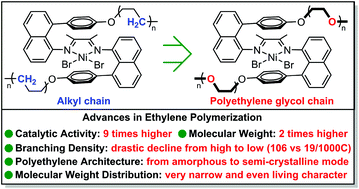Tunable branching and living character in ethylene polymerization using “polyethylene glycol sandwich” α-diimine nickel catalysts†
Abstract
The secondary coordination interaction that differs from ligand steric and electronic modification is an important tool to modulate the olefin polymerization process. In this contribution, by introducing polyethylene glycol units into the seminal α-diimine framework, a new family of “polyethylene glycol sandwich” α-diimine nickel and palladium catalysts was designed and fully synthesized. The nickel catalysts with varying polyethylene glycol units under the activation of an alkyl aluminum reagent drastically enhanced catalytic activities (up to 9 times) and notably were capable of tuning branching densities of the polymer in ethylene polymerization. With the increase of polyethylene glycol units, the microstructures of polyethylene varied from highly branched (106/1000C) to lightly branched (19/1000C). This corresponded to a conversion from amorphous polyethylene to semi-crystalline polyethylene (Tm = 106.7 °C). The probable “ligand–cocatalyst effect” via the chelation of the oxygen atom in polyethylene glycol units with the aluminum atom in the activator was proposed as a unique secondary coordination interaction. The obtained polyethylenes showed very narrow molecular weights (PDI = 1.01–1.59), and even living polymerization of ethylene was possible. In contrast, under the activation of borate, the palladium analogues showed no activities towards ethylene polymerization.

- This article is part of the themed collection: Polymer Chemistry Most Popular 2021


 Please wait while we load your content...
Please wait while we load your content...